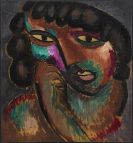
Constantin Brancusi
1876 Hobita, Rumänien
1957 Paris
Constantin Brancusi was an important representative of 20th Century modern sculpture. The sculptor was born on February 19, 1876 in Hobita, Romania. Brancusi began his career as a provincial wood carver. In 1898, he enrolled in the Bucharest School of Fine Arts. Six years later, Brancusi departed on foot from Munich to Paris, where he began studies at the "École des Beaux-Arts". In Paris, Constantin Brancusi initially stood under the influence of Rodin but soon withdrew from it. He increasingly derived impulses from cubism and let himself be inspired by the primitivism of black African art and Romanian folk art.
Constantin Brancusi soon developed his own style, with which he greatly distanced himself from tradition. His work became increasingly oriented toward the goal of discovering the essence of things through the maximal simplification of form. Constantin Brancusi created a process in which he attempted to simplify nature. For example, Brancusi reduced heads to egg-shaped forms that only allowed limited reference to nature. During his artistic career, Constantin Brancusi occupied himself with just a few motifs and became conscious of their effects in the various materials. Brancusi was particularly experimental with the construction of the pedestals, which allowed his sculptures to have their optimal effect. In turn, they appear as stand-alone works of art. The highlight of Constantin Brancusi’s work is the "Ensemble of Tirgu Jiu" (1935-38), which combines his "Table of Silence", "Gate of the Kiss", and the "Endless Column".
During his last phase of productivity, Brancusi’s work was honored in 1955 with a large retrospective at the New York Guggenheim Museum. A year later, he bequeathed his studio with its furnishings to the French state, which had granted him French citizenship in 1952.
Constantin Brancusi died in Paris on March 16, 1957.

Would you like to sell a work by Constantin Brancusi?
Infos for sellerART MARKET:

Oil on paper, laminated on cardboard, 1913
Estimated price 1.500.000
More offers >






